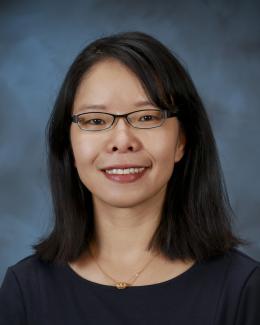August 30, 2016 – Miaofang Chi is an early career scientist making a name for herself—and microscopy—at the Department of Energy's Oak Ridge National Laboratory.
She is a researcher at ORNL’s Center for Nanophase Materials Sciences whose early-career research accomplishments are attracting attention. In the past year, Chi was named ORNL’s 2015 Scientist of the Year and was presented the Director’s Award for Outstanding Individual Accomplishment in Science and Technology. The upstart microscopist also recently accepted the Microscopy Society of America’s Burton Medal, an annual award given to early career trailblazers in the field.
Despite all the awards and accolades, Chi didn’t exactly start out on top.
“I was struggling – a young scientist who had never been at work before,” Chi said, laughing. “So I asked questions: What can I do, how I can find my own research. I asked a lot of questions of everyone. That was the first step.”
Chi's research focus and drive distinguish her. There are two different types of microscopists, she explained. One type focuses on pushing the limit of the technique, like spatial resolution and image resolution; the other is more interested in certain material systems and trying to solve the questions there.
“I just want to know what’s inside,” Chi said, tapping her desk’s wood grain. “I'm the second type, because I’m always interested in materials and their environments, always asking questions.”
Into the Wild
Chi cut her teeth on microscopy as a doctoral student at University of California-Davis, researching at the Lawrence Berkeley and Lawrence Livermore national labs as a visiting scholar and fellow, respectively. “That was the first time I worked on aberration-corrected microscopy, using it to study perovskites,” she said.
She moved from searching within solar materials to studying stardust. In 2006 Chi, then a fellow at Livermore, analyzed dust extracted from comet Wild 2 for insights on interstellar environments.
“It was pretty special,” she said of the stardust study, part of a NASA project. “Because the newest microscopy techniques were very limited to materials science, I was one of the very first people to apply those new techniques to geography and planetary science.”
The microscopist’s time at ORNL started with research focusing on fuel cell catalyst and battery materials. As a postdoc, Chi approached ORNL researcher Nancy Dudney and expressed interest in using microscopy to research ion mass transport in solid electrolyte materials for batteries and fuel cells.
“My PhD was not on any of that, but I thought I could help. I'm very interested in how those surface atomic arrangements could influence the catalytic activities in the material,” Chi recalled. “I talked to her, and said microscopy can really tackle really very unique aspects of those transport behaviors.”
Her insight worked. “That’s how we started with microscopy on that investigation, and how I started working on ion transport in battery materials,” Chi said.
Looking forward
When she thinks about the future of energy research and her own career, Chi speculates that microscopy will play a growing role, especially with many unresolved materials questions at tiny scales – interfaces, surfaces, areas out of equilibrium that make predictions difficult.
“I see myself pushing those microscopy techniques to better understand equilibrium statuses, especially those interfaces and surfaces at atomic scale. A lot of energy devices are limited by those, but not a lot of techniques can even image those areas in question,” Chi said.
Imaging on that scale is looking increasingly possible, since a new, state-of-the-art aberration-corrected electron microscope is slated to arrive at the CNMS, a DOE Office of Science User Facility, later this year. But it’s not just a new instrument, Chi said. Though the new tool will provide much higher spatial and image resolution than current microscopes, the most important part for her is how it will open the field for more imaging solutions to tough science questions.
“Why I am interested in energy materials is because I can connect them so easily to my daily life,” Chi said. “It gives me all the more motivation to keep looking deep for answers."
ORNL is managed by UT-Battelle for the Department of Energy's Office of Science, the single largest supporter of basic research in the physical sciences in the United States. DOE’s Office of Science is working to address some of the most pressing challenges of our time. For more information, please visit energy.gov/science. – by Ashanti B. Washington



